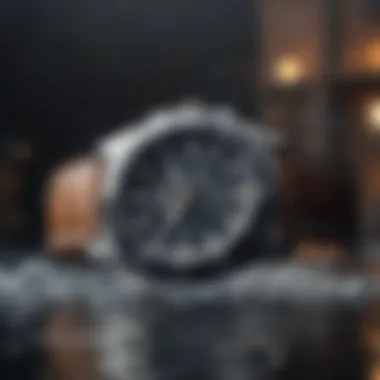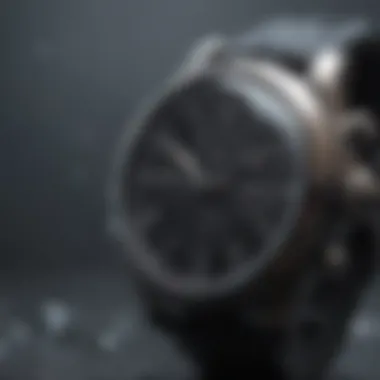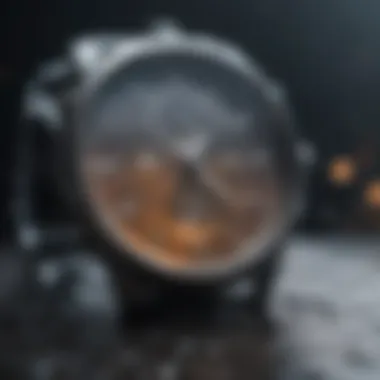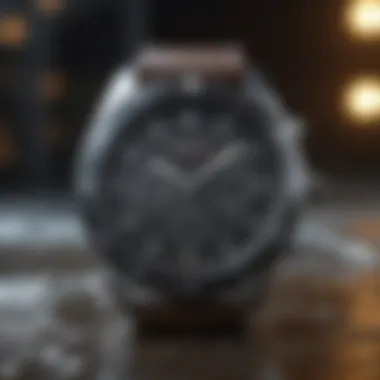Unlocking the Mysteries of Water Resistance in Watches: A Comprehensive Guide


Overview of Water Resistance in Watches
Water resistance in watches is a crucial feature that often confuses many enthusiasts and novices alike. The significance of water resistance cannot be overstated, as it directly impacts the watch's durability and longevity. Understanding the different levels of water resistance, testing methods, and ratings is key to making an informed choice when selecting a timepiece.
Importance of Water Resistance in Watches
Water resistance is a vital aspect of watch design that protects the internal components from damage caused by exposure to moisture. Whether you're wearing your watch in the shower, swimming, or diving, ensuring it has sufficient water resistance is essential to prevent malfunctions and maintain its performance over time.
Deciphering Levels of Water Resistance
The levels of water resistance in watches are typically expressed in meters or atmospheres, indicating the depth to which a watch can withstand water pressure. It is crucial to understand these ratings to avoid exposing your watch to water beyond its capabilities, which could lead to irreversible damage.
Testing and Rating Methods
Manufacturers subject watches to rigorous testing procedures to determine their water resistance levels accurately. These tests involve simulating various water pressure conditions to measure the watch's ability to withstand moisture penetration. The ratings assigned to watches reflect the results of these tests and provide consumers with clear guidance on the watch's water resistance capabilities.
In-Depth Analysis
When delving into the intricacies of water resistance in watches, an in-depth analysis unveils the technical aspects and considerations that influence a watch's ability to resist water intrusion.
Design Features Affecting Water Resistance
The construction of a watch, including the case, crown, crystal, and seals, significantly impacts its water resistance. High-quality materials and precise engineering enhance the watch's ability to maintain its integrity when exposed to moisture, ensuring its longevity and performance in various environments.
Maintenance and Care for Water-Resistant Watches
Proper maintenance is crucial to preserving the water resistance of a watch. Regular checks, servicing, and avoiding unnecessary exposure to water can extend the lifespan of the watch and maintain its performance. Understanding how to care for water-resistant watches is essential for ensuring their continued protection against moisture.
Verifying Water Resistance Claims
It is essential to validate the water resistance claims of a watch by referring to the manufacturer's specifications and recommendations. Despite having a certain level of water resistance, watches may be susceptible to damage if exposed to water in ways not intended by the manufacturer. Following guidelines and understanding limitations is key to preserving the watch's integrity.
Behind the Scenes
Exploring the behind-the-scenes aspects of water resistance in watches offers valuable insights into the craftsmanship, technology, and innovation that drive advancements in this essential feature.
Technological Advancements in Water-Resistant Materials
Manufacturers continually push boundaries in developing new materials and technologies to enhance the water resistance of watches. Innovations in seals, case materials, and testing methodologies contribute to creating watches that offer superior protection against water damage, catering to the diverse needs of consumers.
Collaboration and Research in Watchmaking Industry
Collaborations between watchmakers, researchers, and material scientists drive progress in improving water resistance in watches. By sharing knowledge, conducting experiments, and exchanging ideas, the industry collectively works towards setting new standards and achieving greater reliability in watch water resistance.
Reviews and Recommendations
Evaluating and recommending water-resistant watches involves considering various factors beyond their technical specifications, including user experiences, expert opinions, and real-world performance.


Expert Reviews and Ratings
Watch enthusiasts and industry experts play a vital role in assessing and rating the water resistance of watches. Through thorough testing and evaluation, experts provide valuable insights into the durability, functionality, and water resistance capabilities of different timepieces, guiding consumers in their purchasing decisions..
User Feedback and Recommendations
User reviews and feedback offer authentic perspectives on the practicality and effectiveness of water-resistant watches in daily use. Hearing directly from individuals who have tested the watches in various conditions provides valuable insights for prospective buyers seeking reliable and functional timepieces.
Top Picks and Hidden Gems
Curating a list of top picks and hidden gems among water-resistant watches assists consumers in discovering exceptional timepieces that excel in design, performance, and water resistance features. Highlighting standout watches within different price ranges and styles offers a comprehensive selection for watch aficionados seeking quality and reliability.
Final Thoughts
Navigating the world of water resistance in watches requires a nuanced understanding of the terminology, testing methods, and practical implications of this essential feature. By immersing oneself in the details and intricacies of water resistance, watch enthusiasts can make informed decisions when selecting timepieces that suit their lifestyle and requirements, ensuring both style and functionality in every tick of the watch.
Introduction to Water Resistance in Watches
Water resistance in watches is a crucial feature that often gets overlooked but plays a significant role in the functionality and longevity of timepieces. Understanding the intricacies of water resistance is essential for watch enthusiasts and those who value the protection of their investment. This article aims to shed light on the importance of water resistance in watches, delving into its relevance in maintaining the integrity of timepieces under varying conditions.
Understanding the Significance of Water Resistance
Protecting Your Timepiece
Protecting your timepiece from water damage is a primary concern for watch wearers. The ability of a watch to resist water ingress ensures that its internal components remain unharmed, preserving its accuracy and durability. Choosing a watch with reliable water resistance is paramount for those who engage in water-related activities or face exposure to moisture in their daily lives.
Preventing Water Damage
Preventing water damage is a key function of water-resistant watches. By implementing effective seals and gaskets, these timepieces create a barrier against water intrusion, safeguarding delicate mechanisms from corrosion and malfunction. Opting for a watch equipped with advanced water resistance technology can mitigate the risks associated with water exposure and maintain the performance of the watch over time.
Preserving Longevity
Preserving the longevity of a watch involves ensuring its resilience to external elements like water. Water resistance not only protects the watch in the immediate term but also contributes to its extended lifespan. By investing in a watch with superior water resistance capabilities, owners can enjoy their timepiece for years to come without concerns about water-induced damage.
Common Misconceptions About Water Resistance
Misunderstanding Depth Ratings
One common misconception surrounding water resistance in watches is the misinterpretation of depth ratings. The depth rating indicated on a watch does not solely determine its water resistance level but rather signifies the pressure at which it has been tested. Understanding this distinction is crucial in accurately assessing a watch's suitability for different water-based activities.
Impact of Temperature Changes
The impact of temperature changes on water resistance is often underestimated. Fluctuations in temperature can affect the seals and gaskets of a watch, compromising its ability to withstand water pressure. Awareness of the potential risks posed by temperature variations can help owners maintain the integrity of their water-resistant watches under diverse environmental conditions.
Role of Gaskets and Seals
Gaskets and seals play a critical role in enhancing the water resistance of watches. These components create a protective barrier against water infiltration, ensuring that the internal mechanisms remain unaffected by external moisture. Regular inspection and maintenance of gaskets and seals are essential to uphold the water resistance integrity of a watch and prevent water-related issues.
Factors Influencing Water Resistance


In the vast world of watches, the importance of water resistance cannot be underestimated. The structural components play a pivotal role in determining the level of protection a timepiece can offer against water intrusion. Understanding the intricacies of factors influencing water resistance is crucial in selecting a watch that can withstand varying environmental conditions. Material choices, sealant mechanisms, and construction techniques all contribute to the overall water resistance of a watch.
Structural Components Affecting Water Resistance
Case Material
When discussing water resistance, the case material of a watch is of paramount importance. Materials like stainless steel, titanium, and ceramic are highly regarded for their durability and corrosion resistance. Stainless steel, in particular, is a popular choice due to its strength and resilience against water exposure. However, it is essential to note that titanium offers a lighter alternative with comparable durability. Ceramic, although prone to shattering upon impact, is revered for its scratch-resistant properties, enhancing the overall longevity of the timepiece.
Crystal Type
The crystal of a watch, typically made from materials like sapphire or mineral glass, significantly influences its water resistance capabilities. Sapphire crystal, known for its superior scratch resistance, is a popular choice for water-resistant watches due to its robustness. On the other hand, mineral glass, while more prone to scratching than sapphire, offers better shatter resistance, making it a practical option for sports or diving watches where impacts are more likely.
Crown and Case Back
The crown and case back are often overlooked components of a watch's water resistance. Screw-down crowns, when tightened securely, provide an additional layer of protection against water ingress by creating a watertight seal. Case backs with proper gasket seals ensure that the intricate internal mechanisms remain shielded from moisture and external elements. These components are vital in maintaining the overall water resistance integrity of a timepiece.
Sealing Mechanisms and Technology
O-Rings and Gaskets
O-rings and gaskets are essential sealing components that prevent water from penetrating the sensitive internal parts of a watch. Made from rubber or silicone, these seals create a waterproof barrier when placed in critical junctures of the watch construction. Their flexibility and water-resistant properties make them indispensable in ensuring the longevity of the timepiece's water resistance capabilities.
Screw-Down Crowns
Screw-down crowns, a feature commonly found in dive watches, offer enhanced water resistance by mechanically sealing the crown to the case. This mechanism requires the crown to be tightly screwed in to maintain the water-tight seal, thus safeguarding the internal mechanisms from moisture and pressure. The secure fit provided by screw-down crowns is a vital element in achieving higher water resistance ratings.
Case Construction Techniques
The construction techniques employed in crafting the case greatly impact a watch's water resistance. Methods such as monobloc construction, where the case is fashioned from a single piece of material, enhance the structural integrity of the watch, minimizing potential entry points for water. Additionally, the use of precise machining and sealing technologies further bolster the overall water resistance of the timepiece, ensuring its reliability in varying aquatic environments.
Decoding Water Resistance Ratings
Understanding ATM and Meters
ATM Rating Explained
ATM rating explained unravels the depth at which a watch can resist water pressure and provides valuable insights into a timepiece's overall resilience. This particular aspect enhances the reader's comprehension of water resistance ratings by shedding light on key characteristics and why it serves as a relevant choice for this article. The unique feature of ATM rating explained lies in its straightforward measurement method, offering a clear indication of a watch's water-resistant capabilities. Understanding ATM ratings is essential for consumers looking to purchase watches suitable for various water-related activities.
Conversion to Meters
Conversion to meters equips readers with a comprehensive understanding of the water resistance measurements converted into meters, allowing for a more precise evaluation of a watch's ability to withstand water ingress. This aspect contributes significantly to the overall topic by highlighting key characteristics that make conversion to meters a popular choice for this article. The unique feature of meters conversion lies in its universal applicability across different geographic regions, ensuring consistency in evaluating water resistance regardless of location.
Real-World Application
Illustrating the real-world application of water resistance ratings bridges the gap between theoretical knowledge and practical use. By showcasing scenarios where different levels of water resistance are relevant, readers gain a deeper appreciation for how these ratings impact the functionality of watches in everyday settings. The key characteristic of real-world application is its ability to contextualize technical information, making it a beneficial inclusion in this article. Understanding the practical implications of water resistance ratings aids consumers in selecting timepieces that align with their lifestyle and activities.
Diving Into Specific Ratings
30m Water Resistance


Delving into 30m water resistance elucidates the protection a watch offers against splashes and brief immersion in water. This specific aspect contributes to the overall discussion by highlighting key characteristics that position 30m water resistance as a popular choice for this article. The unique feature of 30m water resistance lies in its suitability for everyday wear, providing a balance between water protection and practicality. While 30m water resistance is ideal for everyday activities, it may not be suitable for prolonged water exposure.
50m Water Resistance
Exploring 50m water resistance showcases a higher level of protection, allowing for limited exposure to water activities such as swimming and snorkeling. By dissecting the key characteristics of 50m water resistance, readers gain insights into why it is a popular choice for this article. The unique feature of 50m water resistance lies in its versatility, catering to individuals with active lifestyles seeking water-resistant timepieces that can withstand moderate aquatic adventures. Despite offering increased protection, 50m water resistance may have limitations when subjected to deeper water immersion.
100m Water Resistance
Unpacking the nuances of 100m water resistance reveals a significant advancement in the watch's ability to resist water pressure, suitable for recreational scuba diving and water sports. By examining the key characteristics of 100m water resistance, readers understand why it is a beneficial choice for this article. The unique feature of 100m water resistance lies in its robust construction and sealing mechanisms, ensuring enhanced durability in challenging aquatic environments. While 100m water resistance surpasses lower ratings in water protection, it is essential to adhere to manufacturer guidelines to maintain its integrity.
Testing Methods for Water Resistance
In the realm of water resistance in watches, understanding testing methods plays a critical role in ensuring the integrity of timepieces. Testing methods serve as the backbone of determining a watch's ability to withstand water ingress, making them a pivotal aspect of this article's exploration into water resistance. By delving into the specifics of testing methods, enthusiasts and novices alike gain valuable insights into the intricate processes that validate a watch's resistance capabilities.
Pressure Testing Procedures
- Dry Testing: Delving into the meticulous process of dry testing sheds light on a crucial aspect of assessing water resistance in watches. Dry testing involves subjecting the timepiece to varying levels of pressure in a dehydrated environment, simulating real-world conditions without the presence of water. This form of testing is renowned for its precision in evaluating a watch's sealing mechanisms, making it a preferred choice for this article. The distinct feature of dry testing lies in its ability to isolate potential vulnerabilities in a watch's construction, providing a comprehensive understanding of its resistance to water intrusion.
- Wet Testing: Wet testing holds its own significance in the realm of evaluating water resistance. By immersing the watch in water and applying pressure, wet testing replicates the actual conditions that a watch may encounter when submerged. The key characteristic of wet testing lies in its ability to assess the watch's performance under water pressure, offering essential insights into its durability in aquatic environments. While wet testing serves as a prevalent choice for assessing water resistance, it also comes with its unique set of advantages and disadvantages that are crucial for readers to comprehend within the context of this article.
- Condensation Testing: An integral component of testing methods, condensation testing plays a pivotal role in ensuring the reliability of water-resistant watches. This method involves subjecting the timepiece to temperature variations to detect any potential condensation inside the watch, indicating a breach in its water resistance capabilities. The unique feature of condensation testing lies in its ability to pinpoint minute flaws that may compromise the watch's ability to resist water ingress, making it a valuable choice for validating a timepiece's performance in challenging conditions specified in this article.
Quality Assurance and Certifications
In the domain of water-resistant watches, quality assurance and certifications hold immense significance, offering consumers assurance regarding the reliability of a watch's water resistance capabilities. By focusing on ISO standards, manufacturer-specific testing, and water resistance certification, this article underscores the crucial role these elements play in validating a watch's resistance to water ingress.
- ISO Standards: Delving into ISO standards unveils a standardized framework for evaluating and certifying the water resistance of watches. By adhering to these globally recognized standards, manufacturers ensure that their timepieces undergo rigorous testing to meet specific criteria, guaranteeing a certain level of water resistance. The key characteristic of ISO standards lies in their comprehensive guidelines, making them a beneficial choice for this article due to their role in establishing an industry-wide benchmark for water resistance.
- Manufacturer-specific Testing: Manufacturer-specific testing delves into the unique methodologies implemented by watchmakers to validate the water resistance of their timepieces. By customizing testing procedures based on individual designs and materials, manufacturers can tailor evaluations to suit the specific requirements of their watches. The distinctive feature of manufacturer-specific testing lies in its ability to provide tailored assessments that directly align with the intricacies of each watch's construction, offering a more personalized approach to ensuring water resistance.
- Water Resistance Certification: Cast in the light of water resistance certification, this section emphasizes the importance of obtaining official certifications to substantiate a watch's resistance to water ingress. Certifications serve as tangible proof of a watch's ability to withstand water exposure, instilling confidence in consumers regarding its durability. The unique feature of water resistance certification lies in its capacity to validate a timepiece's performance according to predefined standards, instigating trust and assurance in the watch's water resistance capabilities showcased within this article.
Maintenance Tips for Water-Resistant Watches
In this section, we will delve into the crucial aspect of maintaining water-resistant watches. Proper maintenance is paramount in ensuring the longevity and performance of your timepiece. By following the recommended care routine, you can protect your watch from water damage and preserve its functionality over time. Regular maintenance not only safeguards your investment but also enhances the overall longevity of your watch collection.
Ensuring Longevity of Water Resistance
Regular Cleaning and Maintenance
Regular cleaning and maintenance play a pivotal role in upholding the water resistance of your watch. By periodically cleaning the case, strap, and seals, you can prevent dirt and debris buildup that may compromise the watch's ability to withstand water. This routine practice aids in preserving the watch's integrity and ensures it performs optimally in various conditions.
Avoiding Extremes in Temperature
Another vital aspect of maintaining water resistance is avoiding exposure to extreme temperatures. Sudden temperature changes can lead to condensation inside the watch case, affecting its internal components and potentially compromising its water resistance. By being mindful of temperature fluctuations and protecting your watch from extreme heat or cold, you can safeguard its structural integrity.
Professional Servicing
Professional servicing by certified watchmakers is essential for ensuring the ongoing water resistance of your timepiece. Regular servicing involves thorough inspection, lubrication, and replacement of worn-out components to maintain the watch's functionality. Professional servicing not only enhances the water resistance capabilities of the watch but also extends its overall lifespan.
Dos and Don'ts for Water-Resistant Watches
Avoiding Exposure to Chemicals
One critical consideration for preserving water resistance is avoiding exposure to chemicals. Chemical substances such as detergents, solvents, and perfumes can degrade the watch's seals and gaskets, compromising its water resistance. By ensuring that your watch is shielded from harmful chemicals, you can prevent damage and uphold its waterproof features effectively.
Proper Usage in Water
Proper usage in water is key to maintaining the water resistance of your watch. While water-resistant timepieces are designed to withstand moisture to a certain extent, excessive exposure to water, especially in activities like swimming or showering, can strain the watch's seals. By following the manufacturer's guidelines on water exposure and limiting prolonged immersion, you can prolong the watch's water resistance.
Checking Seals and Gaskets
Regularly checking the seals and gaskets of your watch is imperative in ensuring its water resistance capabilities. Over time, seals may wear out, rendering the watch vulnerable to water infiltration. By inspecting and replacing damaged seals and gaskets as needed, you can fortify the watch's water resistance and maintain its reliability in wet conditions.



